CAT 4 1/48 F-8 Crusader Conversion Sets
by Hans Gertje
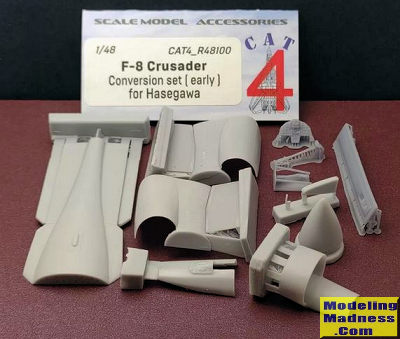 Like many
long-serving aircraft, the Vought F-8 Crusader had an extensive and complicated
history of variants. Variant designations were initially for newly upgraded
production runs, and subsequent remanufacturing programs gave the aircraft new
designations depending on the original variant letter. The differences between
variants are numerous, but a major difference among the aircraft is in the
design of the nose, particularly the radome.
Like many
long-serving aircraft, the Vought F-8 Crusader had an extensive and complicated
history of variants. Variant designations were initially for newly upgraded
production runs, and subsequent remanufacturing programs gave the aircraft new
designations depending on the original variant letter. The differences between
variants are numerous, but a major difference among the aircraft is in the
design of the nose, particularly the radome.
The first four production Crusader
variants (F-8A, B, C, D) all had a smaller radome that was ovoid in cross
section. On the F-8A it only housed a weapon rangefinder, but starting with the
F-8B they were equipped with the AN/APS-67 radar, providing limited all-weather
capability. The F-8C and D received various improvements such as more powerful
engines and stability fins that would become regular features of the aircraft.
The RF-8 Crusader was derived from the F-8A and had this nose shape as well,
albeit with a camera instead of radar.
First flying in 1961, the F-8E
received the more powerful AN/APQ-94 radar, which required a larger
bullet-shaped radome and wider shaped fuselage forward of the instrument panel.
Partway into its production run, the F-8E also introduced a hump-shaped fairing
above the variable incidence wing fuselage section containing electronics for
the seldom-used Bullpup missile.
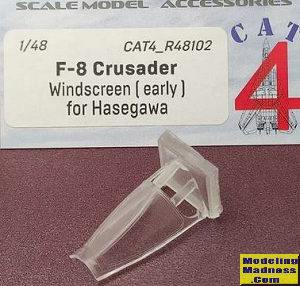 In 1966
Vought introduced a remanufacturing program to upgrade all Crusader variants.
This included updating all existing aircraft with the features installed over
the years, including more powerful engines, ventral strakes, an infrared
scanner, underwing pylons, the Bullpup fairing, improved landing gear, and
various hydraulics and electronics. The one change that F-8A through D models
did not receive was the new radar, so these jets maintained their distinctively
different noses. All upgraded F-8s received new designations:
In 1966
Vought introduced a remanufacturing program to upgrade all Crusader variants.
This included updating all existing aircraft with the features installed over
the years, including more powerful engines, ventral strakes, an infrared
scanner, underwing pylons, the Bullpup fairing, improved landing gear, and
various hydraulics and electronics. The one change that F-8A through D models
did not receive was the new radar, so these jets maintained their distinctively
different noses. All upgraded F-8s received new designations:
F-8B -> F-8L
F-8C -> F-8K
F-8D -> F-8H
F-8E -> F-8J
Certain subjects in modeling are
underrepresented, and for many modelers this can be a source of frustration.
Fans of US Naval aviation may be familiar with this for the F-8 Crusader, as for
many years the only variant that has ever seen a full injection molded kit in
1/32, 1/48, or 1/72 scales is the F-8E/J. Until recently there has never been a
means to build early F-8s and RF-8s straight out of the box, which is a shame
since many of these jets have great schemes, and decal options do exist for
these variants.
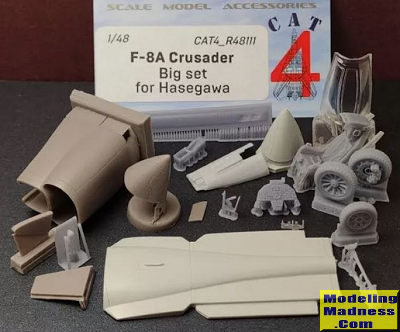 This started
to change in 2023 with Sword’s 1/72 RF-8, a short run kit that has some nice
features, so hopefully this is a good sign for more. For those who still want to
build an early F-8, a conversion kit is needed. These have come and gone over
the years, as Cobra Company, Cutting Edge, and Muroc Models have all released
early F-8 conversion kits with varying degrees of accuracy and completeness.
Finding them long after their production run also means an extensive search,
paying collector prices, and then being assured that the kit is complete and in
good condition. Unless you take on the significant challenge of scratchbuilding
the changes, it’s exceedingly tough to find one of these conversions.
This started
to change in 2023 with Sword’s 1/72 RF-8, a short run kit that has some nice
features, so hopefully this is a good sign for more. For those who still want to
build an early F-8, a conversion kit is needed. These have come and gone over
the years, as Cobra Company, Cutting Edge, and Muroc Models have all released
early F-8 conversion kits with varying degrees of accuracy and completeness.
Finding them long after their production run also means an extensive search,
paying collector prices, and then being assured that the kit is complete and in
good condition. Unless you take on the significant challenge of scratchbuilding
the changes, it’s exceedingly tough to find one of these conversions.
Enter CAT4, a Ukrainian aftermarket
distributor. Established in 2020, they are new to the scene but have already
released over 100 products, mainly to correct and modify existing kits into
different versions. US Navy aircraft particularly seem to have their attention.
Using resin casting and 3D printing, they have stepped in to fill the conversion
kit void for the F-8. Designed for the 2003 Hasegawa tooling, it’s not the
new-tooled kit we want from Tamiya or Eduard (or the variants Hasegawa never
released, for that matter), but it’s something—and now widely available on eBay.
Since May 2024, CAT4 has been
releasing these backdate parts. This included an “early” set for the nose and
hump-less wing, and various individ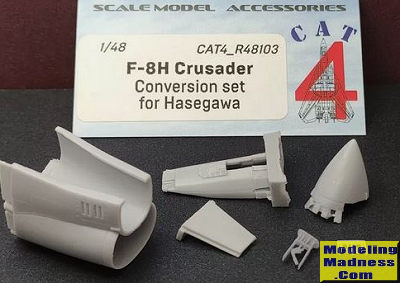 ual
parts sold separately such as the windscreen, wheels, landing gear, and ejection
seats. The main “early” conversion, #48100, doesn’t specify a variant, but the
instrument panel most closely resembles that of a C or D, and has the
conventional grip stick that was seen in the A through C.
ual
parts sold separately such as the windscreen, wheels, landing gear, and ejection
seats. The main “early” conversion, #48100, doesn’t specify a variant, but the
instrument panel most closely resembles that of a C or D, and has the
conventional grip stick that was seen in the A through C.
Early on, 48100 was noted to have an inaccurate radome
shape and ill-fitting nose halves. This was corrected on a subsequent release
for the F-8H (48103), which features a much more accurate shape. Also welcome is
the new single-piece nose, which has a seamless intake with a very thin lip. The
new parts look excellent and much more closely resemble the early radome nose.
CAT4 has also applied these new parts to 48100 – but be sure to ask the
seller for a photo of the kit to make sure it’s the newly corrected release!
Perhaps one of the most welcome
items that CAT4 offered is the corrected windshield (48102), which might be the
toughest roadblock if one chose to accurately scratchbuild an early F-8 without
a conversion kit. This part has the full-length windscreen seen on A through C
and all RF-8s, as these aircraft did not have the infrared scanner.
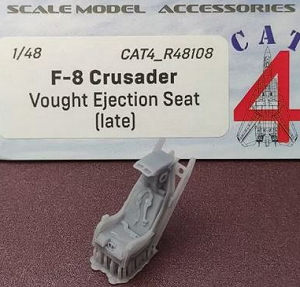 Other
noteworthy additions include early and late versions of the Vought ejection
seats that were used in F-8s up until midway through the C model’s production
run. If one wishes to build a Crusader as it was before retrofit with the MB Mk.
5/7, CAT4 has solved this problem as well.
Other
noteworthy additions include early and late versions of the Vought ejection
seats that were used in F-8s up until midway through the C model’s production
run. If one wishes to build a Crusader as it was before retrofit with the MB Mk.
5/7, CAT4 has solved this problem as well.
In October 2024 a “big set” that
allows backdating to an F-8A appeared on eBay. This set includes all the
required components for building the earliest F-8 model, including the
instrument panel that lacked a radar scope, and also the gear, wheels, and
windscreen.
To a limited degree they have also
released parts in 1/32 and 1/72, such as ejection seats and wheels. Full
conversions in these scales are hopefully coming soon.
 CAT4 has
released an extensive line of parts for the F-8—too many to list here—but they
can all easily be found on eBay and the Plastic Models Store (https://plastic-models-store.com/).
Since there were many differences between all the Crusader variants, I recommend
carefully researching and identifying what components from CAT4 you would need.
A great resource is the SuperHeat Memorial (superheatmemorial.blogspot.com,
curated by Tailspin), which compiles a great deal of knowledge from the late Tom
Weinel. Tom was an F-8 pilot and Vietnam War veteran who was a major source of
information the Crusader on modeling forums. A great place to start is the
summary differences, which can be found here:
https://superheatmemorial.blogspot.com/2018/12/summary-differences-vought-f8uf-8.html
CAT4 has
released an extensive line of parts for the F-8—too many to list here—but they
can all easily be found on eBay and the Plastic Models Store (https://plastic-models-store.com/).
Since there were many differences between all the Crusader variants, I recommend
carefully researching and identifying what components from CAT4 you would need.
A great resource is the SuperHeat Memorial (superheatmemorial.blogspot.com,
curated by Tailspin), which compiles a great deal of knowledge from the late Tom
Weinel. Tom was an F-8 pilot and Vietnam War veteran who was a major source of
information the Crusader on modeling forums. A great place to start is the
summary differences, which can be found here:
https://superheatmemorial.blogspot.com/2018/12/summary-differences-vought-f8uf-8.html
It’s great to see CAT4 putting these conversions out there. As
a Naval Air enthusiast, it’s very exciting to see the possibilities open for
builds of the Crusader. If you have a decal set with a Crusader variant that you
couldn’t use because you couldn’t find a conversion kit, you can now make that
happen. It’s now easier than ever to depict one of VF-84’s flaming “Jolly Roger”
F-8Cs, or an F-8C, D, or H from the Furball MiG Masters sheet. Just make sure
you get a conversion kit with the corrected single piece nose! Big thanks to
CAT4 for coming to the rescue for our favorite modeling subjects.
Hans Gertje
February 2025
Copyright ModelingMadness.com. All rights reserved. No
reproduction in part or in whole without express permission.
If you would like your product reviewed fairly and fairly quickly, please
contact
the editor or see other details in the
Note to
Contributors.
Back to the Main Page
Back to the Review
Index Page
Back to the Previews Index Page
 Like many
long-serving aircraft, the Vought F-8 Crusader had an extensive and complicated
history of variants. Variant designations were initially for newly upgraded
production runs, and subsequent remanufacturing programs gave the aircraft new
designations depending on the original variant letter. The differences between
variants are numerous, but a major difference among the aircraft is in the
design of the nose, particularly the radome.
Like many
long-serving aircraft, the Vought F-8 Crusader had an extensive and complicated
history of variants. Variant designations were initially for newly upgraded
production runs, and subsequent remanufacturing programs gave the aircraft new
designations depending on the original variant letter. The differences between
variants are numerous, but a major difference among the aircraft is in the
design of the nose, particularly the radome.  In 1966
Vought introduced a remanufacturing program to upgrade all Crusader variants.
This included updating all existing aircraft with the features installed over
the years, including more powerful engines, ventral strakes, an infrared
scanner, underwing pylons, the Bullpup fairing, improved landing gear, and
various hydraulics and electronics. The one change that F-8A through D models
did not receive was the new radar, so these jets maintained their distinctively
different noses. All upgraded F-8s received new designations:
In 1966
Vought introduced a remanufacturing program to upgrade all Crusader variants.
This included updating all existing aircraft with the features installed over
the years, including more powerful engines, ventral strakes, an infrared
scanner, underwing pylons, the Bullpup fairing, improved landing gear, and
various hydraulics and electronics. The one change that F-8A through D models
did not receive was the new radar, so these jets maintained their distinctively
different noses. All upgraded F-8s received new designations:  This started
to change in 2023 with Sword’s 1/72 RF-8, a short run kit that has some nice
features, so hopefully this is a good sign for more. For those who still want to
build an early F-8, a conversion kit is needed. These have come and gone over
the years, as Cobra Company, Cutting Edge, and Muroc Models have all released
early F-8 conversion kits with varying degrees of accuracy and completeness.
Finding them long after their production run also means an extensive search,
paying collector prices, and then being assured that the kit is complete and in
good condition. Unless you take on the significant challenge of scratchbuilding
the changes, it’s exceedingly tough to find one of these conversions.
This started
to change in 2023 with Sword’s 1/72 RF-8, a short run kit that has some nice
features, so hopefully this is a good sign for more. For those who still want to
build an early F-8, a conversion kit is needed. These have come and gone over
the years, as Cobra Company, Cutting Edge, and Muroc Models have all released
early F-8 conversion kits with varying degrees of accuracy and completeness.
Finding them long after their production run also means an extensive search,
paying collector prices, and then being assured that the kit is complete and in
good condition. Unless you take on the significant challenge of scratchbuilding
the changes, it’s exceedingly tough to find one of these conversions.  ual
parts sold separately such as the windscreen, wheels, landing gear, and ejection
seats. The main “early” conversion, #48100, doesn’t specify a variant, but the
instrument panel most closely resembles that of a C or D, and has the
conventional grip stick that was seen in the A through C.
ual
parts sold separately such as the windscreen, wheels, landing gear, and ejection
seats. The main “early” conversion, #48100, doesn’t specify a variant, but the
instrument panel most closely resembles that of a C or D, and has the
conventional grip stick that was seen in the A through C. Other
noteworthy additions include early and late versions of the Vought ejection
seats that were used in F-8s up until midway through the C model’s production
run. If one wishes to build a Crusader as it was before retrofit with the MB Mk.
5/7, CAT4 has solved this problem as well.
Other
noteworthy additions include early and late versions of the Vought ejection
seats that were used in F-8s up until midway through the C model’s production
run. If one wishes to build a Crusader as it was before retrofit with the MB Mk.
5/7, CAT4 has solved this problem as well.  CAT4 has
released an extensive line of parts for the F-8—too many to list here—but they
can all easily be found on eBay and the Plastic Models Store (
CAT4 has
released an extensive line of parts for the F-8—too many to list here—but they
can all easily be found on eBay and the Plastic Models Store (